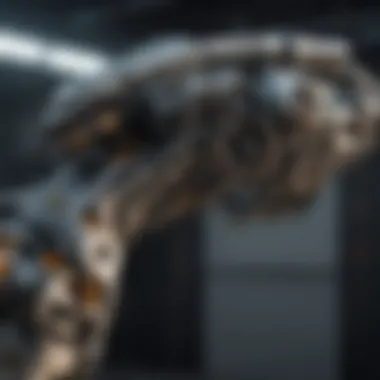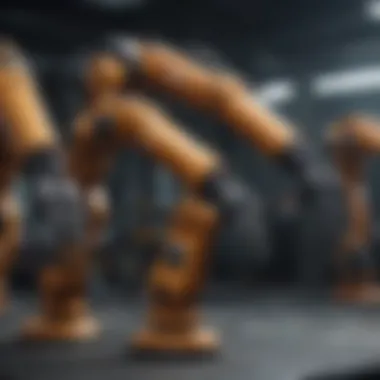Understanding Robotic Arms: An In-Depth Analysis


Intro
Robotic arms are engineered devices with a wide range of applications that touch various aspects of modern life. They serve as vital components in industries such as manufacturing, healthcare, and even aerospace. Understanding these intricate mechanisms begins with grasping their design and functionality. This article examines the components, the technological advancements that propel them, and the industries where they are employed.
The evolution of robotic arms has drastically altered traditional work environments. They now perform tasks that enhance efficiency and precision, often surpassing human capabilities in specific applications. However, this transformation also leads to discussions regarding the implications on the workforce and society at large. We aim to provide insights that cater to professionals, educators, and students interested in robotics.
In the subsequent sections, we will explore the key findings related to robotic arms. The discussion focuses on various results and the methodologies used in their development. This exploration will lay the foundation for a broader understanding of robotic arms, encapsulating their present state and potential future trajectories.
Prelude to Robotic Arms
The study and development of robotic arms is a critical area within robotics, highlighting the intersection of mechanical engineering, computer science, and artificial intelligence. Robotic arms are versatile tools that exhibit precision, repeatability, and the ability to perform complex tasks. This topic is vital as it shapes various industries, enhancing productivity and innovation.
Robotic arms can be programmed to perform tasks ranging from simple pick-and-place operations to intricate surgical procedures. Their implementation not only increases efficiency but also improves safety, especially in hazardous environments. As industries continue to seek automation solutions, understanding how robotic arms work and the technology behind them becomes increasingly relevant.
With advancements in technology, the capabilities of robotic arms have expanded. They incorporate sophisticated control systems and sensor technologies that allow them to adapt to changing environments. Therefore, this section sets the foundation for exploring the components, types, and applications of robotic arms in subsequent parts of the article.
Defining Robotic Arms
Robotic arms are mechanical devices designed to mimic the functions of a human arm. They are typically articulated, consisting of segments that are connected by joints, allowing for a range of motion. These devices can be controlled by a computer program, making them capable of performing tasks with high precision.
Their design qualifies them for various applications, especially in manufacturing, where they can assemble products, weld, or perform quality inspections. Key characteristics of robotic arms include:
- Articulation: This allows for movement similar to human joints.
- Precision: They can perform tasks with a very high degree of accuracy.
- Automation: Programs can control their movements for consistency in performance.
Understanding the intricacies of robotic arms begins with defining their construction and functionalities, which reflects their complexity and utility in modern technology.
Historical Context
The history of robotic arms dates back to the mid-20th century, marking significant milestones in the evolution of automation. Initially, the inception of robotic arms aimed to reduce the labor cost and improve efficiency in production lines. Notable developments include:
- 1956: George Devol created the first programmable robotic arm, known as Unimate, designed for industrial applications.
- 1961: Unimate was introduced into a General Motors assembly line for die-casting operations, establishing a precedent for robotic arms in manufacturing.
Subsequent innovations focused on enhancing their capabilities, including the advent of computer technologies that enabled more sophisticated programming and control. Over decades, these machines have evolved from simple tasks to complex operations in various sectors, including healthcare and space exploration. This historical backdrop provides a context for understanding the current technologies and advancements in robotic arms.
Components of Robotic Arms
The components of robotic arms are fundamental to their design and operation. Understanding these elements is crucial for grasping how robotic arms function in various applications. These components make robotic arms efficient, precise, and versatile. Without a thorough understanding of these parts, it becomes challenging to appreciate the advancements in robotic technology.
Mechanical Structures
Mechanical structures form the backbone of any robotic arm. They consist of links and joints that enable movement and articulation. The design and materials used for these structures affect the overall performance. Lightweight materials, such as aluminum or carbon fiber, are often preferred as they reduce inertia and allow for faster movements.
Moreover, the configuration of the mechanical structure determines the range of motion. There are several configurations, including serial and parallel structures. Serial structures have a series of joints that require intricate motion for positioning. In contrast, parallel structures offer greater stability and load-bearing capacity.
"The design of the mechanical structure directly influences the efficiency and effectiveness of a robotic arm's operations."
Control Systems
Control systems are vital for the operation of robotic arms. They manage the input and output signals that dictate the arm's movements. These systems can range from simple command-based controls to complex ones that incorporate feedback and sensory data.
A common type of control system used is the PID (Proportional, Integral, Derivative) controller. This system helps maintain desired positions and velocities by continuously adjusting the inputs based on feedback. Advances in embedded systems and microcontrollers also enhance the capabilities of robotic arm control. These technologies allow for more sophisticated algorithms, enabling robots to adapt to changes in their environment.
Actuators and Sensors
Actuators are essential components that provide the motion in robotic arms. These devices convert energy into mechanical motion. Different types of actuators are available, including electric motors, pneumatic cylinders, and hydraulic systems. Electric motors are prevalent due to their precision and ease of control.
Sensors, on the other hand, are responsible for feedback. They provide critical data about the arm's position, speed, and external conditions. Common types of sensors include encoders, force sensors, and cameras. The integration of sensors with actuators leads to improved accuracy and functionality in robotic systems. This synergy is particularly important in applications requiring high precision, such as in the medical field or during intricate assembly tasks.
Incorporating both actuators and sensors allows robotic arms to perform complex tasks with a high degree of accuracy and reliability. This combination can adjust to dynamic situations, making the robotic arm more adaptive and efficient in various environments.
Types of Robotic Arms


Understanding the types of robotic arms is crucial for a comprehensive grasp of their capabilities. Each type serves a specific purpose and has unique benefits that cater to different industries. Knowing these distinctions helps professionals choose the right robotic arm for their applications. Key considerations include the precision required, workspace limitations, and the nature of tasks.
Articulated Robotic Arms
Articulated robotic arms are among the most versatile types of robotic systems. They typically feature rotary joints, mimicking the movements of a human arm. This design enables a high degree of freedom, allowing them to perform complex operations.
- Flexibility: Articulated arms can reach around obstacles, making them ideal for intricate tasks.
- Applications: They are widely utilized in manufacturing, welding, and assembly.
- Precision: Advanced models incorporate sensors for enhanced accuracy.
In essence, articulated robotic arms exemplify adaptability and precision, suitable for a variety of challenging environments.
SCARA Robots
SCARA robots have a distinctive design that allows horizontal movement. The acronym stands for Selective Compliance Assembly Robot Arm. This configuration makes them ideal for tasks requiring speed and precision.
- Speed: SCARA robots excel at quick pick-and-place operations.
- Workspace: They generally operate in a limited vertical range but can cover a broad horizontal plane.
- Uses: Commonly employed in electronics assembly and packaging, they offer a balance between speed and accuracy.
SCARA robots showcase a specialized approach to robotics, efficiently addressing demands in assembly lines.
Delta Robots
Delta robots are renowned for their unique parallel link system. They consist of three or more arms connected to a common base. This structure provides exceptional speed and precision.
- Speed: Delta robots can operate at high speeds, making them ideal for tasks like food handling and pharmaceuticals.
- Accuracy: Their design mitigates inertia, enhancing precision in movement.
- Multi-Tasking: Capable of executing multiple tasks, they are efficient in high-volume operations.
Delta robots represent a fusion of speed and precision, making them vital in fast-paced environments.
Collaborative Robots (Cobots)
Collaborative robots, often referred to as cobots, are designed to work alongside humans. Their integration into workplaces reflects a shift toward more user-friendly automation.
- Safety: Cobots prioritize safety with features to prevent accidents in shared spaces.
- Ease of Use: They often require less programming knowledge, enabling effectively integrating into various industries.
- Applications: Cobots are increasingly found in assembly lines, packaging, and laboratories to assist human workers.
Collaborative robots symbolize a new era in robotics where human and machine collaboration becomes seamless.
The advancement of robotic arms significantly impacts productivity across various sectors, making the understanding of their types essential for industry stakeholders.
Technological Underpinnings
In the realm of robotic arms, the technological underpinnings serve as the backbone for innovation and functionality. This section aims to elucidate the core technologies that form the foundation of modern robotic arms. Knowing these elements is crucial for comprehending both their capabilities and limitations.
Artificial Intelligence in Robotics
Artificial Intelligence, or AI, is transforming robotics by enabling machines to learn and adapt. This shift from pre-programmed responses to AI-driven decision-making opens a new dimension for robotic arms. By utilizing AI, robotic arms can interpret sensory data, recognize patterns, and adjust their actions accordingly. For instance, an AI-enabled arm in a manufacturing setting can enhance precision by learning from previous tasks.
Moreover, AI can help streamline operations. When integrated into robotic arms, AI systems can optimize workflows, thus increasing efficiency and reducing downtime. This application of AI not only boosts productivity but also minimizes errors, leading to improved quality in products.
Machine Learning Applications
Machine Learning (ML), a subset of AI, plays a vital role in enhancing robotic functions. ML algorithms allow robotic arms to improve their performance over time. For example, a robotic arm used in assembly tasks can analyze its previous outputs, learn from mistakes, and fine-tune its movements for better efficiency. This self-improvement aspect is crucial.
Furthermore, ML can assist in predictive maintenance. By analyzing operational data, robotic arms can forecast when they might fail or need servicing. This predictive maintenance can save costs and prevent unnecessary downtimes, ultimately benefiting the overall productivity in industries.
Simulation and Control Software
The effectiveness of robotic arms is heavily reliant on robust simulation and control software. These tools are essential for designing, testing, and operating robotic systems. Simulation software allows engineers to model and simulate robotic operations in a virtual environment before actual implementation. This approach helps to identify potential issues and optimize programming without any real-world risks.
Control software, on the other hand, governs the actions of robotic arms in real-time. It translates the programmed instructions into precise movements, ensuring that the robotic arm operates as intended. Control software often incorporates feedback mechanisms that help the arm adjust its tasks on-the-fly, maintaining accuracy throughout its operations.
"The integration of advanced technologies into robotic arms leads to exceptional improvements in performance and adaptability, redefining operational standards across various industries."
Applications of Robotic Arms


Robotic arms have become increasingly crucial across various sectors due to their precision, efficiency, and ability to perform repetitive tasks without fatigue. These machines are not just tools; they represent a significant technological advancement that enhances productivity and safety in numerous fields. This section delves into key applications for robotic arms, highlighting specific benefits and considerations, ensuring a comprehensive understanding of their impact.
Manufacturing Industry
In the manufacturing realm, robotic arms are vital for automation. They streamline processes, reducing human error and increasing output. Generally, these robots manage tasks like assembly, welding, painting, and packaging. For example, in automotive manufacturing, robotic arms are essential for assembling car components with high accuracy.
Benefits in manufacturing include:
- Increased productivity
- Reduced labor costs
- Enhanced quality control
- Safety improvements for workers by handling dangerous tasks
However, companies face challenges like the need for skilled workers to manage these systems and the initial investment costs associated with automation.
Medical Field
In healthcare, robotic arms revolutionize surgical procedures and patient care. These machines can perform complex surgeries with enhanced precision. The da Vinci Surgical System offers minimally invasive options, leading to shorter recovery times for patients.
Applications in medicine involve:
- Surgery
- Rehabilitation
- Diagnostics
Robotic arms also assist in medical training, allowing practitioners to simulate procedures in a controlled environment. Despite their advantages, ethical concerns regarding reliance on machines in critical procedures and patient care persist.
Space Exploration
Robotic arms play a significant role in space exploration. NASA’s robotic arms, like the Canadarm2 on the International Space Station, are essential for maintenance, repairing equipment, and deploying satellites. These arms operate in conditions that are challenging for humans, proving to be indispensable for missions.
The advantages include:
- Performing tasks in harsh environments
- Reducing risks to human astronauts
- Collecting data without immediate human oversight
Agriculture and Farming
In agriculture, robotic arms enhance efficiency in tasks such as planting, harvesting, and even packing produce. Precision farming benefits from these technologies as they can monitor crop health and automate tasks.
Key points about agricultural robotic arms are:
- Labor shortage solutions
- Improved crop yields
- Environmentally friendly farming practices
Adopting these technologies raises considerations about cost and the need for technician training to handle advanced machines.
Consumer Robotics
The rise of consumer robotics has led to household applications of robotic arms. Robots like those made by iRobot and others can perform cleaning tasks, making daily life more convenient.
Considerations for consumer robotic arms include:
- User-friendly interfaces
- Incremental integration into household tasks
- Assisting disabled individuals
While the industry grows, it also prompts discussions about privacy and security, as these devices often require data collection to function efficiently.
"Robotic arms in consumer applications mark a shift toward automation in our everyday lives, reflecting technological progress."
The integration of robotic arms in various fields illustrates a trend toward automation characterized by improved efficiency and safety. As industries continue to explore their capabilities, these machines will likely become even more integral to daily operations across sectors.
Challenges in Robotic Arm Development
The realm of robotic arms has garnered significant attention in recent years due to their vital role in automation across various sectors. However, the development of these sophisticated machines brings forth several challenges that warrant thorough examination. By understanding these obstacles, we can better appreciate the complexity involved and the potential for advancements in robotic technology. This section addresses the technical limitations, ethical concerns, and economic implications that accompany robotic arm development, providing a nuanced view of the landscape.
Technical Limitations
Robotic arms are not immune to technical challenges. Their limitations often stem from several factors, notably the complexity of their mechanical components and control systems. One of the major restrictions is the precision and accuracy of movement. For instance, even a slight malfunction in a sensor can lead to significant errors in task execution.


- Limited Range of Motion: Many robotic arms are designed with a specific range of motion. This restricts their ability to adapt to varied tasks or environments.
- Force and Payload Constraints: The strength of robotic arms can significantly vary. Some may not be able to handle heavy loads, while others might lack the finesse required for delicate operations.
- Integration Challenges: Integrating sensors and actuators with control systems can be complex. Mismatched components may lead to inefficiencies.
These overall limitations create a hurdle for industries aiming for seamless automation. Engineers must consistently innovate to enhance performance and reliability in robotic arms.
Ethical Concerns
As robotic arms become more prevalent in industries such as healthcare and manufacturing, ethical considerations also emerge. A key ethical dilemma revolves around the displacement of human workers. Organizations that integrate robotic arms may reduce their workforce, leading to job losses and economic uncertainty for many individuals.
- Responsibility and Accountability: Who is responsible when a robotic arm malfunctions and causes harm? Assigning liability can be challenging, as it involves questions of accountability for designers, manufacturers, and operators.
- Data Privacy: Many modern robotic arms depend on data to operate effectively. This raises concerns about data security and privacy, especially in sectors like healthcare where sensitive information is managed.
- Bias in Algorithms: If the algorithms governing robotic arms are biased, they may lead to unfair outcomes in applications like caregiving or law enforcement.
These ethical issues necessitate ongoing dialogue among stakeholders to navigate the implications of adopting robotic technology responsibly.
Economic Implications
The economic landscape also faces transformation due to the deployment of robotic arms. These technologies promise increased efficiency and productivity but come with costs and consequences worth discussing.
- Initial Investment: The upfront costs associated with purchasing and implementing robotic arms can be substantial. Many small businesses find it hard to justify such investments.
- Return on Investment: While the long-term benefits can be significant, businesses must carefully analyze their ROI to ensure that incorporating robotic arms leads to profitability.
- Impact on Employment: As discussed earlier, automation can lead to job displacement. This has broad implications for the economy, including potential increases in unemployment and shifts in the labor market.
In summary, the challenges associated with robotic arm development encompass technical constraints, ethical dilemmas, and economic effects. Addressing these challenges is essential for the holistic progress of robotic technology. As industries continue to adopt these robotic innovations, a balanced understanding of their complexities will drive more responsible and informed advancements.
Future of Robotic Arms
The exploration of the future of robotic arms is essential in understanding their potential evolution and impact on various industries. As technology progresses, robotic arms stand at the forefront of innovation, driven by advancements in artificial intelligence and machine learning. These developments not only enhance their functionality but also broaden their applicability across numerous sectors. The importance of examining this future lies in the opportunity to grasp both the benefits and challenges associated with integrating robotics into daily operations and workflows.
Emerging Trends
The landscape of robotic arms is rapidly changing. Key trends include miniaturization, increased dexterity, enhanced communication capabilities, and improved sensing technologies.
- Miniaturization: Smaller and lighter robotic arms are making it feasible to use them in confined spaces or mobile applications. These developments allow for portability and ease of use in varied environments.
- Increased Dexterity: Research is focusing on creating robotic joints that mimic human movements more closely. This improved dexterity allows robotic arms to perform complex tasks in industries like surgery and delicate assembly.
- Enhanced Communication: Robotic arms are increasingly able to communicate with other machines and systems through IoT technology. This integration facilitates automation across different platforms and optimizes workflows.
- Improved Sensing Technologies: Advances in sensors enable robotic arms to adapt to their environment, enhancing precision and safety. They can now better sense their surroundings and avoid obstacles, leading to more effective operation.
These trends position robotic arms as indispensable tools and reinforce their evolving role in technology.
Integrating IoT with Robotics
The integration of Internet of Things (IoT) with robotics is a pivotal aspect in the future of robotic arms. By connecting robotic arms to the internet, it allows for real-time data exchange and remote monitoring. This connectivity can lead to enhanced decision-making and operational efficiency.
- Data Collection: IoT-enabled robotic arms can collect vast amounts of data about their performance and surrounding conditions. This data can facilitate predictive maintenance, reducing downtime and operational costs.
- Remote Operation: Companies can control robotic arms remotely, allowing for effective use in hazardous or hard-to-reach areas. This capability can apply in fields such as construction, manufacturing, and healthcare.
- Adaptive Learning: With ongoing data input, robotic arms can learn from their experiences. They can adapt their actions based on environmental changes, improving their efficiency and accuracy over time.
The synthesis of IoT and robotics creates not just smarter machines but a more integrated operational approach across industries.
Robotics in Everyday Life
The presence of robotic arms in daily life is becoming increasingly common. From home automation to healthcare enhancements, these machines are reshaping how people interact with technology.
- Home Automation: Robotic arms are utilized in smart home devices, simplifying tasks like garbage sorting, cleaning, and even cooking. This development reflects a growing trend toward greater convenience in everyday chores.
- Healthcare Advances: In healthcare, robotic arms assist in surgeries, drug delivery, and rehabilitation. Their precision can significantly enhance outcomes, providing surgeons with improved capabilities and aiding in patient recovery processes.
- Educational Tools: In educational settings, robotic arms are becoming tools for teaching programming and engineering concepts. They provide an engaging method for learning about automation and robotics.
Culmination
In summing up the various aspects of robotic arms, this article underscores their significant impact across multiple domains. The detailed exploration of their design, mechanisms, and applications provides a solid framework for understanding this complex technology. Robotic arms are not just mechanical constructs but are key players in sectors ranging from manufacturing to medicine. The ever-evolving nature of these machines reflects a commitment to addressing modern challenges and enhancing efficiency.
Summary of Insights
Throughout the article, we have discussed the major components of robotic arms—mechanical structures, control systems, and actuators. We reviewed several types, such as articulated, SCARA, and delta robots, emphasizing their distinct characteristics and uses.
Key points include:
- The fundamental role of artificial intelligence in optimizing robotic performance.
- Applications of robotic arms in diverse fields, making them versatile tools.
- Challenges they face, particularly in terms of technical limitations and ethical implications.
Such insights clarify the component technologies that enable robotic arms to perform tasks with precision. Additionally, understanding the advancements and obstacles within this field provides context for future exploration.
The Path Forward
Looking ahead, the future of robotic arms appears promising with emerging trends driven by innovation. Integrating robotic arms with the Internet of Things (IoT) will further enhance their abilities, allowing for smarter and more interconnected machines. The practical applications of these advancements extend into everyday life, influencing sectors like healthcare, where robotic assistance is expected to revolutionize surgery and patient care.
Continued research and development in robotics emphasize the necessity of ethical considerations. As robotic arms become more prevalent, the dialogue surrounding their impact on employment and safety will grow increasingly important. Adapting to this landscape will require a balance between progress and ethical responsibility.
"The journey of robotic arms from industrial uses to personal applications reflects a broader trend of automation in our lives."



